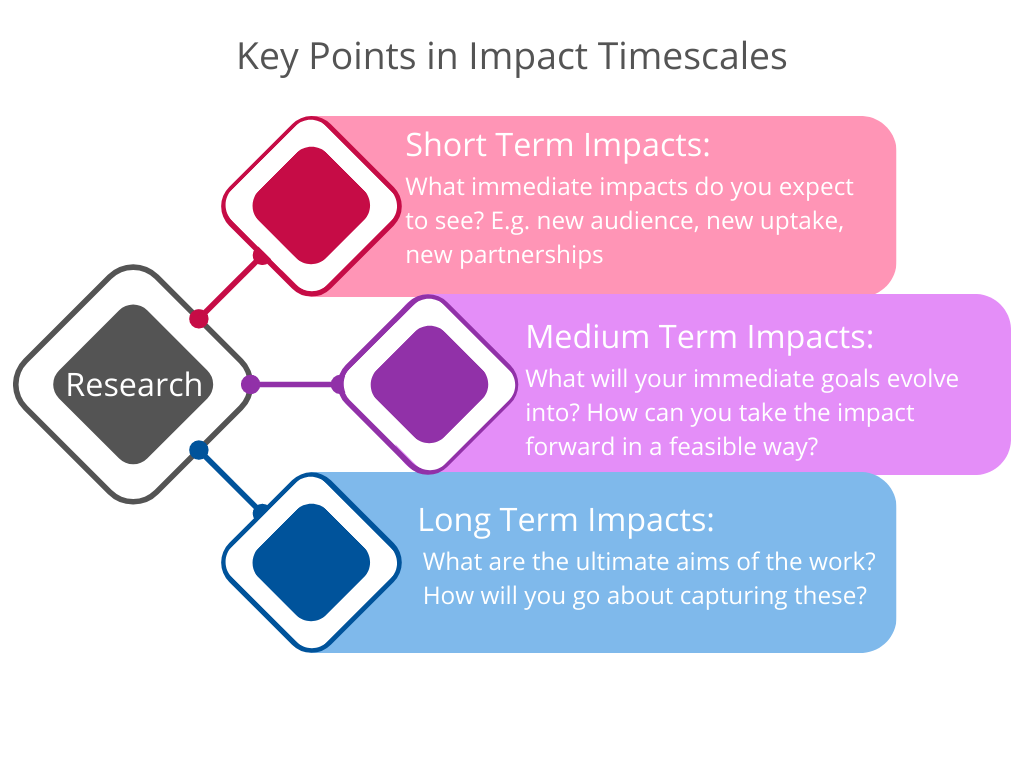Planning the timescales, milestones and KPIs of impact work in a clear, feasible and measurable way early in a project maximises opportunities to deliver impact and to create a detailed impact narrative. Impact narratives allow you to communicate the value of the benefits your research has brought about and can contribute to a variety of uses including reporting on funding, REF Impact Case Studies, applying for funding and career progression.
When establishing your impact timescales, there are several factors to consider. This resource will explain key stages in timescale planning, allowing you to reflect on how you can create a timescale which will allow you to pace, evidence and optimise your impact.
There are five key aspects to research work which leads to impact:
- Inputs – What you need to conduct your research
- Activities – What you do as part of disseminating your research and its outcomes
- Outputs – The products and deliverables of your research underpinned impact activities
- Outcomes – The effects and change of your research and associated activities
- Impact – The societal benefit arising from your research and associated activities
Each stage of the pathway has different degrees of research involvement/influence and timescales. The diagram below demonstrates this journey from research to impact, with key examples under each of the five stages. It is based on the W.K. Kellogg Foundation Logic Model.
When planning impact, bridging the stages between research and change are key. Strong connections between each stage of this journey result in changes which are are ultimately likely to be more sustainable, far-reaching and significant.
Impact Stages
Within engagement and impact work, there are three stages: short, medium and long term. Each of these stages requires some planning and it is important to capture evidence of impact at each stage, particularly for REF.
There are various sources of internally managed impact funding to support each stage of the impact journey. It is important overall, through the various developments, to be able to trace the thread back to the underpinning research as clearly as possible. This can be particularly challenging where the research may be integrated with multiple other sources. For REF, the research should make a difference to the impact outcomes such that without it the impact would either not have happened or would have been substantially reduced.
Gathering impact evidence is vital at key impact stages, where impact takes a new turn, escalates or intensifies.
Examples of natural points at which to collect evidence are when:
- you have held an event
- you are in the position to gain feedback (with a new intervention, new resource or new prototype)
- the research has gained increased media attention
- you have involvement in a group/thinktank/consortium which has used your research
At points such as this, it is important to capture evidence of the change your research is making. This can be via the collection of metrics, testimonials, uptake increases and various other ways. You can plan in evidence capture methods as you embed impact into your project planning.
If you apply for impact funding, there are some additional factors to plan in. It can be helpful to ask yourself:
- Am I seeking funding for short-, medium-, or long-term impact-generating activities?
- Does my application reflect this appropriately?
- How can I look beyond the proposed project work and is there anything I can add now which will make that step more streamlined?
- Have I planned in appropriate impact evidence capture and developed a strategy for it?
Fast-Fail Milestones
When planning an impact project, there are points at which certain things must happen for the project to progress. This may be having key people at an event, a core component of prototypal development, or other opportunity which are instrumental to the project progressing beyond it. Adding fast-fail milestones allows others to understand the priorities of the work, as well as assess the proposed timeline. It also allows for project plans to include alternative scenarios based on outcomes of the fast-fail milestones.
Gantt Chart Plotting
In our funding applications, we generally ask for a Gantt chart which illustrates the key timescales, milestones and fast-fail points in your project. These charts should be clear and include the following:
- Breakdown of project tasks (these may be framed as work packages if there are multiple stages to the project)
- When each task will begin and end
- Who will be involved at each stage (PI, Co-I, externals, etc.)
- Milestones (including fast-fail): key points/stages of the proposed work
We provide a basic blank Gantt chart here.
If you would like to learn more about funding your research impact work, see our resources which detail our funding portfolio and processes.


